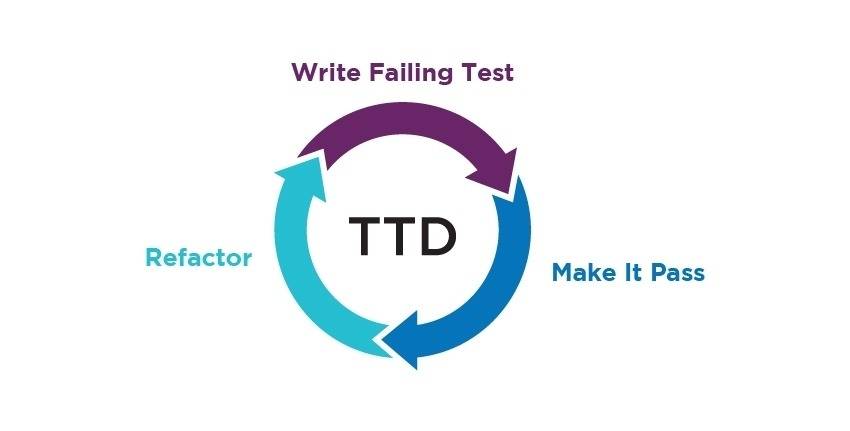
What is Test-Driven Development? (TDD)
Test-Driven Development (TDD) is a software development approach in which tests go hand-in-hand with the coding/development process. As a result, the TDD process assures that the requirements and the software code are perfectly aligned.
The requirements are turned into highly specific test cases that specify the desired functionality. Then, using these test cases as a guide, code is built. The developers will focus more on the requirements and specifications if the tests are created before the code.
Initially, the code is designed in such a way that it fails the test. When a test fails for the predicted reasons, the developer creates the bare minimum of code that passes the test case. All test cases should succeed both individually and when compiled, and they should not break or influence any current feature or functionality. The code is then refactored to conform to the standards, with duplication eliminated from the codebase.
- TDD software development methodology produces flexible, bug-free code, high test coverage, and increased test productivity.
- TDD is an extension of extreme programming that implements the agile strategy of iteratively producing software using clean, simple designs and code.
Let’s take a deeper look at the Test-Driven Development process and see what benefits your project will receive from using it.
1. Project documentation in great detail
When building tests for specific needs, programmers write a precise specification right away. It already incorporates all of the actions that users are likely to take.
As a result, we already have a scenario that will guide us ahead. You won’t have to write any lengthy documentation, which saves time and work for both you and the coders.
Programmers start with user stories to ensure that the unit test is thorough and behaves appropriately. The outcomes are simple and consistent, bringing the code as near to all of the criteria as feasible.
2. Flexibility in the code and ease of maintenance
Developers seek fewer errors while creating code, which has a significant impact on corporate expenditures.
Implementing Test Driven Development decreases the percentage of errors by almost 80 percent, which means that resolving them takes less time.
Refactoring is an aspect of the TDD process that involves optimizing existing code to make it more readable and simpler to implement. It promotes a clean and appealing code structure. Even non-developers can sometimes decipher the code and grasp its meaning.
The overall aesthetic of the structure is also very essential. The clear interface is respected by developers even at the stage of generating tests. It signifies that this section is already present in the code and that it meets the demands of both clients and users.
3. Improved program design and code quality
When developing tests, programmers must first decide what they want to accomplish with the code. Developers estimate the experience it will provide as well as how it will interact with other parts of the code. Everything, from an interface to a work plan, is kept in mind by a developer.
TDD also aligns well with the Don’t Repeat Yourself (DRY) philosophy. It states that programmers should minimize the use of similar code in various portions of the system. The benefit of this approach is that it encourages programmers to employ tiny classes and methods to meet specific needs. This makes it easier to define system objects and keep the codebase consistent.
Then, when developers use TDD to write code, it improves the quality. Why do you think that is? Because all potential blunders and errors have already been considered. Developers write the appropriate tests, as well as the code, to ensure that no errors occur. As a result, the code appears to provide superior outcomes.
Finally, when your code is well-structured and meets the test criteria, it is easy to read, understand, and write. No large code blocks are preventing the solution from working. Even if there are none, programmers modify the code to make the entire structure easier to understand.
4. You’ll receive a dependable solution with TDD
Without TDD, new members or inductees to the developer team remain ignorant of recent changes, and they are unsure how new development will interact with previously faultless code, they cannot understand it.
Investing in TDD from the start of the project will allow new developers to gel into the development process much smoother. They can go back and know exactly what code is written, reviewed, and tested in any phase of the development project.
Project expenses can be reduced
Last but not least, implementing TDD will drastically reduce the cost of project development. This is the outcome of all of the previously described advantages, namely:
- The versatile code you receive will be easy to maintain and expand.
- Any future additions or development will be safe with this solution.
- You will have ready-to-use documentation that may be utilized for a variety of reasons in the future.
- The product generated with TDD has a much greater quality.
Considering the points mentioned above, project stages such as bug fixing and maintenance will take less time using TDD. As a result, whether you’re building a unique marketplace website or working on SaaS product development, you’ll need a lesser budget.
Cool Technologies on the Horizon
Along with TDD, there are several best practices to enhance the final code, including CI, Code Reviews, Refactoring, and others. However, aside from technology, you need to examine other hurdles to find a solution that truly matches all of your criteria. Explore manual testing and automated testing methods through defect management tools to find the perfect balance.
Source: https://www.kualitee.com/development/how-can-tdd-be-a-game-changer-for-your-softwares-quality/